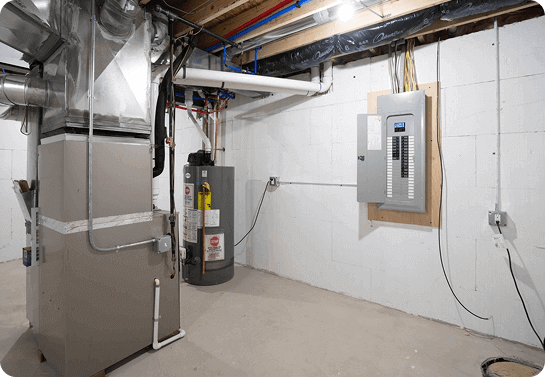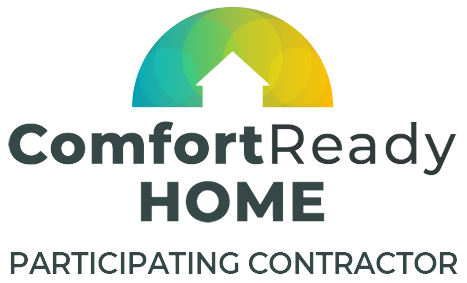Imagine this—it’s a freezing winter morning, and you’re huddled under layers of blankets because your furnace refuses to turn on. It was working just fine a few days ago, so what happened? A non-functional furnace isn’t just uncomfortable—it can also mean frozen pipes, potential structural damage, or even safety hazards in your home.
Before you panic, know that there are several reasons why your furnace might fail to turn on, many of which are simple to diagnose and fix. Here’s a guide to the most common issues and what you can do to address them (plus how to know when it’s time to call in the pros).
5 Common Reasons Your Furnace Won’t Turn On
1. Thermostat Issues
A faulty thermostat is one of the most common reasons a furnace refuses to turn on. If your thermostat isn’t reading the room’s temperature correctly or fails to send the “heat-on” signal to the furnace, it disrupts the entire heating process. Digital thermostats, in particular, might lose their programming after a power outage, leaving your furnace inactive without you realizing it.
2. Pilot Light Problems
If your furnace relies on a pilot light, it may occasionally go out. Whether it’s due to a draft, a dirty ignition source, or issues with the gas supply, a non-functioning pilot light prevents your furnace from heating your home. The ignition system must be functioning for the furnace to start, so even a small problem here can cause a complete shutdown.
3. Electrical Problems
Gas or propane-powered furnaces rely on electricity to function. If you’re dealing with tripped circuit breakers or a blown fuse, this could be disrupting your furnace’s operation. Frequent electrical trips could point to larger problems with your system or your home’s overall power capacity.
4. Clogged Air Filter
When was the last time you checked your furnace’s air filter? Over time, dust, dirt, and debris builds up, restricting airflow and making the furnace work harder to circulate warm air. This leads to uneven heating in your home or even causes the furnace to overheat and shut down completely.
5. Malfunctioning Blower Motor
The blower motor is the powerhouse responsible for distributing warm air throughout your home. If it’s broken, worn out, or malfunctioning, your furnace won’t be able to push heated air into your living spaces. This could leave your home feeling like an icebox.
These are just a few common reasons why a furnace might not turn on. But before you call in a heating technician, there are a few steps you can take to troubleshoot the problem yourself. We’ll get to that in the next section.
What You Can Do Before Calling a Professional
While some issues require the expertise of a professional, there are a handful of checks and fixes you can perform to get your furnace running again. Let’s get into them:
1. Check the Thermostat
Make sure your thermostat is set to “Heating” mode and that the temperature is set higher than the current room temperature. If your thermostat is displaying an error code, consult the user manual or the manufacturer’s website for troubleshooting tips.
Steps:
- Make sure the thermostat is set to “heat” mode.
- Ensure the temperature is set higher than the current room temperature.
- Replace batteries if your thermostat is battery-operated or check for error messages.
2. Inspect the Electrical Panel
Check your home’s electrical panel and ensure all switches controlling your HVAC system are turned on. If there are any tripped breakers, reset them. However, if a circuit breaker keeps tripping repeatedly, it might be a sign of a larger electrical problem.
3. Confirm the Gas Supply
If you have a gas furnace, ensure the gas supply is on and the valve is fully open. We’ve had customers call us only to realize their gas was turned off because they forgot to register their utility bill after moving. If you have a gas stove, light a burner to confirm your gas supply is working.
4. Examine the Air Filter
A dirty air filter is one of the simplest yet most overlooked causes of furnace problems. Depending on the type of filter your furnace uses, either replace it with a new one or clean the reusable filter. Doing so can restore airflow and improve the performance of your system.
5. Relight the Pilot Light
If your pilot light is out, most furnaces will have relighting instructions on the service panel. You can try reigniting it cautiously. However, if the pilot light refuses to stay lit, it may indicate a larger issue, and at that point, a professional assessment will be necessary.
When Should You Call a Professional?
It’s essential to know when the problem goes beyond what you can fix safely and effectively. Some signs to watch for include blocked ducts, persistent electrical problems, or more complex mechanical issues.
Blocked Ducts
This is a big issue. When ducts are blocked, air pressure builds up, which not only reduces airflow but also causes dust, dirt, and grime to accumulate. Over time, this degradation of air quality can lead to health issues and, in the worst case, create a fire hazard. For example, one of our customers experienced constant sneezing and allergy flare-ups every time the furnace kicked on. It turned out one of his ducts was clogged, and the blowback of dust and pollutants triggered his allergies.
Circuit Breaker Keeps Tripping
You can reset your circuit breaker once, but if it keeps tripping, it’s a sign of a bigger electrical issue. If your furnace is drawing more power than the circuit can handle, it could mean the furnace is malfunctioning or that the breaker is underpowered. Either way, it’s time to call in a professional to avoid potential damage or safety risks.
Pilot Light Keeps Going Out
A pilot light going out once in a while may not be a cause for concern, but if it keeps happening, it’s a trend that should be addressed. The pilot light is critical for igniting the burners in your furnace. If it keeps going out, it’s best to have a professional technician inspect your furnace. Continuing to relight the pilot without addressing the root cause could cause further damage or even pose serious safety risks, such as a gas leak.
Safety Features Are Triggered
Modern furnaces have built-in safety sensors that ensure proper operation. If something goes wrong, these sensors will shut the system down to prevent damage or hazards. Some key safety features include:
- Flame Out: If flames escape the combustion chamber, the system will automatically shut down.
- Pressure Switch: If flue gases aren’t properly vented and start to back up, the system will shut down.
- High Limit Switch: If your furnace gets too hot, the high limit switch will turn it off to prevent overheating.
- Safety Float Switch: Some systems have drain pans to collect condensation. If the pan fills up, the system won’t run to avoid overflow or water damage.
Blown Motor
The blower motor is the heart and soul of your furnace—it’s responsible for pushing warm air throughout your home. If the motor blows out, your furnace can’t circulate heat, leaving you cold. A blown motor can result from overheating, electrical issues, or wear and tear. Unfortunately, there’s no fix for a blown motor—it must be replaced. This can be costly, but necessary to get your furnace back up and running.
Burned Capacitors or Resistors
Your furnace contains electrical boards, and over time, the individual components—like capacitors or resistors—can burn out. The constant heat and cooling cycles stress these parts, eventually leading to failure. When this happens, your furnace may experience poor performance or stop working entirely. This is a repair job that requires a professional.
Flame Sensor Problems
The flame sensor detects the presence of the pilot light. When it becomes dirty from carbon buildup, it can shut down the entire system as a safety measure. The good news is that this can often be fixed with a simple cleaning. However, this isn’t a DIY job—flame sensors are delicate, and using harsh chemicals or improper cleaning methods can damage them. We’ve seen people accidentally ruin the sensor while trying to clean it themselves, resulting in a costly replacement.
Broken Furnace Door
The furnace door needs to close tightly to maintain the right environment inside the unit. If the door is slammed or mishandled, it can affect the seal between the door and the furnace, sometimes even twisting the hinges. A broken door can cause your furnace to run inefficiently or even lead to safety issues. If the door no longer fits properly, it’s time to call in a pro to fix the alignment and restore proper function.
How to Avoid Future Furnace Problems
The best way to keep your furnace running smoothly is through regular and preventative maintenance. A well-maintained furnace can provide decades of reliable service. Start by replacing air filters regularly and being gentle with your system—avoid banging on the furnace or slamming its doors.
Additionally, consider enrolling in a maintenance program with a professional HVAC service. At Fast Heating & Air, we offer year-round inspection and maintenance services keeping your heating system in top condition. Our expert technicians can catch potential issues early, saving you from costly repairs and ensuring your furnace operates efficiently.
Contact Fast Heating And Air For Furnace Repair Today
When your furnace stops working, don’t panic. From thermostat mishaps to clogged filters, many common issues can be resolved with a bit of troubleshooting. But when DIY fixes fall short, trust the seasoned professionals at Fast Heating & Air to get your system back up and running quickly. We’ll diagnose the problem, perform high-quality repairs, and provide maintenance tips to help prevent future breakdowns.
Don’t wait for the next cold morning. Contact us today to schedule an appointment or talk to one of our experienced technicians for fast, reliable furnace repair services.







